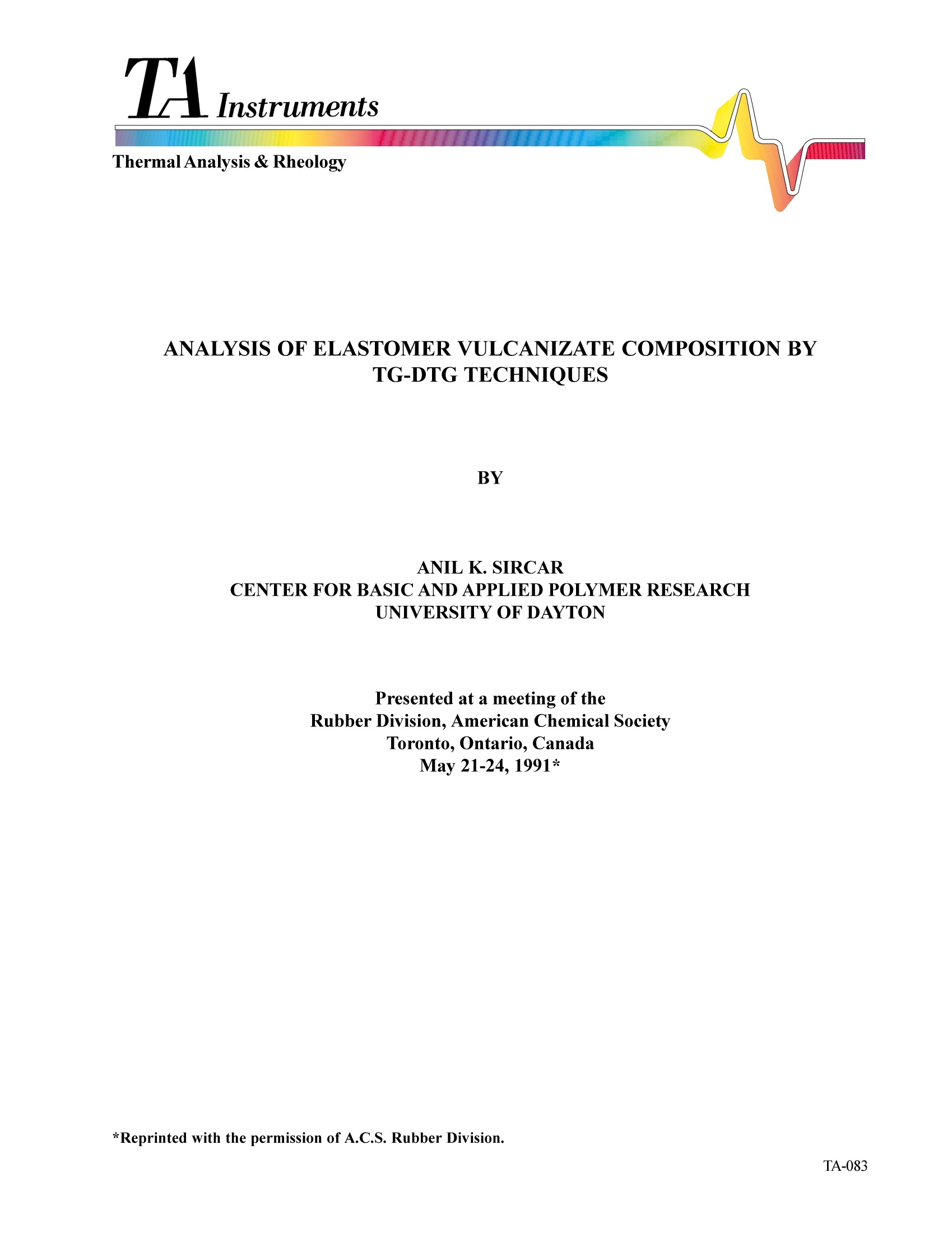方案详情文
智能文字提取功能测试中
TABLE II TABLE III Thermal Analysis & Rheology ANALYSIS OF ELASTOMER VULCANIZATE COMPOSITION BYTG-DTG TECHNIQUES BY ANIL K. SIRCARCENTER FOR BASIC AND APPLIED POLYMER RESEARCHUNIVERSITY OF DAYTON Presented at a meeting of the Rubber Division, American Chemical Society Toronto,Ontario, Canada May 21-24,1991* SUMMARY Two common problems in the TG-DTG analysis of unknown elastomer vulcanizates and probable solutions arediscussed. The first problem concerns the difficulty in quantitatively determining the oil and elastomer in the com-pound in cases where their volatilization temperature range overlaps. After a review of the published works whichstudied this problem, isothermal TG (with or without vacuum) along with the use of "High Resolution" TG equipmentis recommended. The second problem concerns separate determination of carbon residue from the elastomers and added carbon black inthe compound, which very often oxidizes together. Subtraction of the carbon residue formed by the elastomers,determined by previous analyses, from the total weight loss in oxygen, was suggested in the literature. However, thequantity of char depends on type of the elastomer, as well as its concentration, curative type and amount and rate ofheating. The problem is not, therefore, fully resolved. Experiments under slow feed of lean oxygen gas and isothermaltemperature were also suggested in the literature. Under this condition, oxidation of carbon black and char may occurat slightly different temperatures and overlapping is minimized. However, this could be achieved only for large andmedium particle size blacks (soft blacks) which oxidize at higher temperatures and not for the smaller particle sizeblacks, (used mostly in tire treads). Further work under slow feed of lean oxygen with a superimposed isothermalprogram and/or vacuum is recommended. The capability of the recently announced "High Resolution Thermogravi-metric Analyzer" should also be explored. INTRODUCTION Analysis of elastomer vulcanizate composition is often an important quality control requirement for the rubber industry.Practical rubber formulations are complex mixtures of polymer(s), filler(s), oil, plasticizer, curatives, antioxidants(2),antiozonant(s), and processing aids. The classical ASTM method takes too long to analyze this complex mixture to beof much practical use on a routine basis. It is also costly and very often requires preliminary identification of thepolymer type. Thermogravimetry (TG) is currently gaining wide acceptance as a method for compositional analysis of vulcanizates.The recent ASTM symposium on "Compositional Analysis by Thermogravimetry"? attests to this observation. Thermo-gravimetric analysis not only permits the analysis to be completed in a short time but also requires a small sample. The first examples of using TG to analyze polymeric materials are found in the work of Chiu’, Maurer4.5, and Coats andRedfern. Swarin and Wims’ made a special effort to accurately determine the oil content of vulcanizates, which oftenvolatilize with the elastomer, and proposed simultaneous use of the derivative thermogravimetry (DTG) curve. Excel-lent precision and good accuracy were also reported by Maurer’ for a series of vulcanizates of single elastomers basedon ethylene-propylene-diene rubber (EPDM), isobutylene-isoprene rubber (IIR), chloro-isobutylene-isoprene rubber(CIIR), and natural rubber (NR). Harris’ used the TG method for quality control of carbon black masterbatches ofstyrene-butadiene rubber (SBR) and butadiene rubber (BR), including oil-extended materials. Leyden and Raablanalyzed a formulation based on SBR. The potential of the TG-DTG procedure for quantitative analysis ofvulcanizates based on binary elastomer blends was also treated by Maurerll.12 for EPDM-NR blends and by Brazier andNickell3 for natural rubber-synthetic isoprene rubber (IR), NR-BR, and NR-SBR blends. Wide acceptance of themethod resulted in an ASTM test method in 1987 entitled, "Compositional Analysis by Thermogravimetry"4. AnInternational Standard Organization (ISO) method is also under development. Several factors can contribute to interference with this simple TG-DTG procedure16,17. One factor is overlap of theprocess oil, resin etcetera. with the polymer decomposition region. The second, by far the greatest complication, isobserved for the elastomers with a heteroatom in the monomer, e.g., acrylonitrile-butadiene rubber (NBR), chloroprenerubber (CR), poly(vinyl chloride) (PVC), chloro-sulfonated poly(ethylene) rubber (CSM, Hypalon), poly(acrylates)(ACM), fluoro elastomers (FKM), epichlorohydrin polymer (CO), epichlorohydrin-ethylene oxide copolymeretc. The (ECO)se polymers leave a char (carbon residue) after degradation in nitrogen, making it difficult to estimate eitherthe elastomer or carbon black included in the recipe. The purpose of this review is to discuss the procedures that havebeen suggested to remedy these apparent inadequacies of the TG-DTG method. DTG curves for elastomers have also been used as "fingerprints" to identify many single elastomers and blends16.Quantitative determination of the ratio of elastomers12.17 has also been attempted from DTG peak heights11,13,18. Inorder to focus our attention to the compositional analysis of the vulcanizates, these other capabilities of DTG have beenprecluded from this discussion. SCHEMATIC TG AND DTG CURVE OFELASTOMERVULCANIZATES19 Figure 1 Table 1DEFINITIONS OF DIFFERENT FRACTIONS IN THERMOGRAVIMETRIC ANALYSIS OFELASTOMERS Highly volatile matter Refers to moisture, polymer, diluent, oil, plasticizer, emulsifiers (e.g.in styrene-butadiene rubbers), curatives (sulfur, accelerator),antioxidants, antiozonants, and other low boiling components (approx.300°C or lower) Medium volatilematter Refers to medium volatility material such as processingoil, process-ing aid,elastomer, resin (used as a curing agent) etc. In general,these materials degrade at 300 to 750C. Combustible material Refers to oxidizable material, not volatile (in the unoxidized form) at750℃ or some stipulated temperature dependent on the material(e.g.,carbon black, graphite,etc.). Ash Refers to nonvolatile residues in an oxidizing atmosphere which mayinclude metallic oxides, filler or inert reinforcing material (e.g. silica).In the absence of nonblack fillers, the ash is composed of zinc oxidewhich is a component in most vulcanizates. A small amount of ash(<1%) may be due to elastomer residue. EXPERIMENTAL A schematic TG-DTG curve of elastomer vulcanizate analysis is shown in Figure 1 to illustrate the procedure. Thestandard test method for compositional analysis by TG15,20 describes a general technique to determine the quantity offour arbitrarily defined components -1) highly volatile matter, 2) matter of medium volatility, 3) combustible material,and 4) ash left after oxidative decomposition of inorganic components. The components filling this description in thecase of elastomer vulcanizates are shown in Figure 1 and Table I. The definitions of the four components are based ontheir relative volatility or lack of it. The success of the method depends on the differing thermal stability ranges foreach component in an inert and an oxidizing atmosphere. The analysis is performed by first taring the electrobalance, introducing and weighing the specimen, and establishingthe inert atmosphere. The desired heating program is then initiated while the specimen mass is continuously moni-tored by a recording device. The mass loss profile may be expressed in either milligrams or percent of the originalsample mass. Once the medium volatile matter mass loss plateau is established, usually at 600℃ or above, the atmo-sphere is changed from inert to oxidative. In the case of elastomer vulcanizates, the sample is often cooled to 400℃ in Figure 2 nitrogen before changing to an oxidative atmosphere, since many carbon blacks oxidize below 600℃. This modifiedprocedure often allows identification of carbon blacks from DTG peak temperatures5.12. The analysis is complete whenmass loss plateau corresponding to the final sample mass is established. The method encompasses all commercial andspecially designed thermogravimetric analyzers capable of temperature programming while continually weighing thesample under atmospheric control. Specimens are generally solid (but may be liquid, e.g. latex) and are generally 10 to20 mg in size. Selection of test parameters includes a modular approach using a combination of optimal heat and holdperiods. The smaller sample size provides better resolution of the curves and can be more advantageously used withmore recent instruments which have better sensitivity. The use of small sample size and low heating rate have beenstressed by several reviewers6.21,22. A higher conductivity purge gas (helium) has also been claimed to be helpful. RESULTS AND DISCUSSION Determination of "Highly Volatile Matter" A. Moisture and Process Solvent-Table I shows that the "highly volatile matter" may contain a low boiling fractionconsisting of moisture, polymer-diluent, etc. Analysis of water and process solvents could best be accomplished byholding the sample at an isothermal condition under inert atmosphere and possibly under reduced pressure, as a firststep in the TG procedure. This analysis may also be accomplished and facilitated by the use of the DSC curve (Figure2). TG-DTG CURVES OF EPR VULCANIZATES Figure 3 Figure 4 B. Curatives and Antioxidants-Other components mentioned in Table I under "highly volatile matter" are thecuratives (excess sulfur, accelerator, emulsifiers (e.g. in SBR) and the antioxidants). Relatively little note has beentaken of the analysis of these low molecular weight organic components which are almost always volatilized under300℃ and included under "oils and plasticizers". Jaroszyn' ska and Kleps24 show a small discontinuity at 300℃ in theTG-DTG curves of ethylene-propylene rubber (EPM) and NR-SBR before volatilization of oil at 350℃ (Figures 3 and4). They ascribe the initial decrease in mass to the loss of excess curatives and organic antioxidants. As is evidentfrom Figures 3 and 4, the exact separation of the decomposition ranges of these two groups, even with the use of DTG,is very difficult. Comparatively better results may be obtained by using the graphical method of Swarin and Wims’, tobe described later. In mixes which do not contain oil, the quantity of compounding ingredients may be determined upto the decomposition temperature of 300℃. This, however, requires a previous knowledge of the polymer type. VOLATILIZATION RANGE OF PLASTICIZER/OIL IN NITROGEN VOLATILIZATION/OXIDATION TEMPERATURE OF DIFFERENTCOMPONENTS IN TG-DTG EXPERIMENTS25 Constituent Material Temperature in ℃ Atmosphere gas Initial Median Final Napthenic Oil 205 253 300 Nitrogen Highly Aromatic Oil 250 295 340 Nitrogen Paraffinic Oil 342 381 420 Nitrogen Chlorobutyl Rubber 352 395 437 Nitrogen Natural Rubber (SMR-5) 385 408 430 Nitrogen Chloroprene Rubber 372 441 510 Nitrogen SBR 445 473 500 Nitrogen EPDM 480 490 500 Nitrogen Carbon Black (N-339) 540 545 550 Oxygen Carbon Black (N660) 545 550 555 Oxygen Calcium Carbonate - 825 - Nitrogen/Oxygen Graphite 一 800 - Oxygen C. Oil and Plasticizer- As mentioned before, a major challenge in the TG-DTG analysis of elastomer vulcanizates isto accurately assay oil/plasticizer and the polymer, which often show overlapping TG curves. Figure 5 is a collection ofTG volatilization curves for three typical plasticizers25. Most of these materials have volatilization ranges rather thandiscrete volatilization points because they are chemical blends of various molecular weights of different volatility.Figure 6 is a collection ofTG-volatilization curves for three typical elastomers. Table II lists the initial, median andfinal temperatures of several representative samples of elastomers, carbon blacks, graphite, and calcium carbonate. It isevident from Figures 5 and 6 and Table II that overlapping of the oil and elastomer TG curves is highly probable,especially if the oil belongs to the less volatile paraffinic type. Many other process oils, plasticizers and processing aidsdecompose similarly at a high temperature along with the elastomer. VOLATILIZATION RANGE OF ELASTOMERS IN NITROGEN TEMPERATURE (C) Figure 6 CHARACTERISTICS OF OIL LOSS REGIONSIN TG CURVES IN NITROGEN ·"Light"Oil (A) Polymer Fillers + Ash V Polymer + (B) "Heavy" Oil Fillers + Ash 4 Figure 7 Curve B of Figure 2 includes a resin curing agent which degrades along with the polymer. In this case, a portion of theelastomer is decomposed before the complete removal of oil fragments and neither the oil nor the polymer can beaccurately determined by a single dynamic TG-DTG curve. The TG curves of "light oil" and "heavy oil" in a typicalpolymer, presented in Figure 7, show a sharp break between the "polymer" and "light oil" TG curves and no discerniblebreak between the "polymer" and "heavy oil" curves. Swarin and Wims’ suggest three methods to resolve this problem in the case of EPDM vulcanizates; these are illus-trated in Figure 8. Their three approaches are 1) overlay the 2TG1 1cusrvee of an unextended elastomer obtained at thesame experimental conditions as the oil-extended sample; 2) use a graphical extrapolation technique based on theintersection of the linear regions of the TG curves due to oil only and polymer plus oil; and 3) use the minimum of thesimultaneous DTG curve to determine when the oil loss is complete. METHODS FOR THE DETERMINATION OF OIL AND POLYMER IN EPDM RUBBER BY TG. A. OVERLAY METHOD B. EXTRAPOLATION METHOD C. DERIVATIVE METHOD Figure 8 Both methods 1 and 3 showed excellent agreement with the known values in the case of EPDM rubber which decom-poses at a higher temperature than the unsaturated diene rubbers (NR, SBR, and BR). The extrapolation method(method 2) was not satisfactory for the heavier oil even for EPDM. However,method 1 requires a knowledge of theelastomer type as well as the experimental conditions for cure. It also requires extra work for graphical extrapolation.Increased stability of the elastomers on cure may also add to the complication. Artemov et al.28 reports that thevolatilization temperature for dibutyl phthalate plasticizer depends on the nature of the curative. These considerationsmake the value of method 1 doubtful for analysis of an unknown vulcanizate. Thus, method 3 is the preferred method.However, resolution of the TG-DTG curves of many practical vulcanizates are not quite as good as shown in Figure 8,making the location of the minimum in DTG curve rather subjective. An example for a SBR track pad rubber formula-tion for the Army2930, is shown in Figure 9. TG-DTG ANALYSIS OF A SBR VULCANIZATE Figure 9 Additional suggestions in early work by Maurer were as follows: 1. Extract the sample to remove oil, excess curatives, etc., prior to TG analysis. This provides a reasonable estimate ofoil/plasticizer content if corrected for various low molecular polymeric and nonpolymeric (excess curatives, antioxidantfragments, etc.) material removed with the oil. However, composition of the vulcanizate is altered by extraction, andthe lengthy extraction procedure is time consuming. The method therefore offers little advantage over the classicalchemical method. 2. Establish a "correction curve" based on a reference temperature for a given polymer compound. This procedure issomewhat lengthy and requires knowledge of the polymer and oil types as well as the curatives. 3. Analyze isothermally below the polymer decomposition temperature. 4. Use reduced pressure to aid in removing oil at a lower temperature where polymer decomposition is not significant. Both methods 3 and 4 have attracted renewed interest recently and will be discussed next. Zeyen advocated isothermal TG to estimate oil and plasticizer. He recommended dynamic TG to identify the tempera-ture ranges and then to run isothermal TG at selected temperatures within the range to establish a "critical tempera-ture" that permits the volatilization of the oil/plasticizer but does not volatilize the elastomer. Figure 10 illustrates theuse of the isothermal TG on a rubber compound to confirm that the "critical temperature" has been correctly defined.Note that the sample is held at a constant temperature until the mass loss curve becomes constant. Zeyen observes thatthe analytical data for oil/plasticizer obtained by the isothermal method are a much better match to the known valuesthan those determined by ASTM extraction method (ASTM D-297). The method works well for aromatic andnapthenic oils. Paraffinic oils, used primarily in molded rubber goods (particularly in EPDM compounds), stillcovolatilize along with a portion of the polymer. ISOTHERMAL TG CURVE FOR AN OIL IN NITROGEN Figure 10 Another suggested solution is to use reduced pressure to alter the volatilization temperature of the oil and separate itfrom the polymer. Figure 11, scan A shows the effect of running the polymer alone in a nitrogen atmosphere versusrunning it under a vacuum of 0.5 mm of mercury3. Scan B shows a similar curve for process oil alone. The reducedpressure has a greater effect on the oil than on the polymer. This is clearly shown in scan C; the weight loss steps of 25percent oil plus polymer are not resolved in nitrogen but are resolved at reduced pressure. Scans D and E show twomore examples of polymer/oil weight loss resolution under vacuum versus nitrogen. Scan F shows a three componentmixture into which air is introduced after the polymer loss has been completed. The usefulness of TG in studying oil/polymer separation in vacuo was also mentioned by T. Elisabeth² in 1983. POLYMER/OIL WEIGHT LOSS RESOLUTION UNDER VACUUM VS NITROGEN Figure 11 TG-DTG CURVE OF OIL/RUBBER ATATMOSPHERIC PRESSURE IN NITROGEN Figure 12 The method was further refined by Groves and Thomas33 who combined isothermal TG with the vacuum technique.This is illustrated in Figures 12 through 14 for an unknown sample. TG-DTG in nitrogen indicates covolatilization ofoil and rubber (Figure 12). Separation is slightly better in vacuum (Figure 13). Figure 14, where the vacuum andisothermal techniques were combined, shows complete separation of the oil and elastomer. The small dip in the TGcurve is due to vacuum release. Incidentally, one of the TG manufacturersrecently announced a "High ResolutionThermogravimetric Analyzer" which, it claims, automatically senses the need and provides for an isothermal period,thereby eliminating the need for a preliminary dynamic TG run to locate the temperature range. The general conceptof varying heating rate during TG weight changes is not new. The literature contains several references35-38 whichclearly illustrate that adjusting (slowing) the heating rate during weight changes improves resolution. However, incontrast to automatic sensing, these methods lengthen the experimental time substantially. Data are now beinggenerated at the author’s laboratory to explore the potential of this new method to provide better resolution of oil/plasticizer and elastomer curves. TG-DTG CURVE OF OIL/RUBBER UNDERREDUCED PRESSURE TIME (min) Figure 13 TG-DTG CURVE OF OIL/RUBBER UNDER ISOTHERMAL AND REDUCED PRESSURESHOWING COMPLETE SEPARATION OF OIL FROM RUBBER Figure 14 Determination of Polymer and Carbon Black in Elastomers with a Heteroatom As mentioned before, the second and by far the greatest complication in compositional analysis of elastomer recipes byTG-DTG procedures is observed for polymers with a heteroatom in the constituent monomer. These polymers leave acarbonaceous residue (char) after degradation in nitrogen which is oxidized along with the carbon black included in therecipe when the environment is changed to air or oxygen. This gives a higher estimation of carbon black and a lowervalue of polymer than are actually present. Table III shows the amount of carbonaceous residues obtained by pyrolyzing elastomers with different heteroatoms1739.Similar data for chlorinated elastomers are shown in Table IV.40 Data for NBR copolymers will be presented later. Itmay be observed from Tables III and IV that carbonaceous residues estimated by different workers from the samplepolymers are somewhat different. This is attributed to the following factors: 1) different chlorine content of differentPoly (chloroprene) rubbers4, 2) temperature of determination, 3) after treatment, (e.g., prolonged heating) and 4) rateof heating42. The amount of carbon residue depends on the polymer structure as well as the amount of chlorine in thepolymer, and increases with the chlorine content in the same class of polymer. From a study of the degradation ofchlorine containing polymers by TG, Jaroszyn’ ska et al.4 suggested that the quantity of nonvolatile carbon residuedepends to a higher degree on the structure and ratio of the number of hydrogen atoms to chlorine atoms than on thechlorine content of the polymer. As may be observed in Table IV, PVC has the highest percentage of chlorine butleaves a substantially lower percentage of carbon residue than either chloroprene rubbers or Hydrin 100 after degrada-tion. The literature data indicate that the chloroprene rubbers and the NBR copolymers, two commercially importantelastomer categories, produce more char than the other elastomers studied and this introduces more error in thecompositional analysis by TG. Therefore, our discussion shall be confined to TG-DTG analyses of these two elastomercategories in the rest of this review. DTG CHARACTERISTICS AND CARBONACEOUS RESIDUES FORMISCELLANEOUS ELASTOMERS TYPE ELASTOMER % CARBONACEOUS CR RESIDUE (550°℃)17.39 NEOPRENE W 21.0 NEOPRENE GT 22.0 NEOPRENE AJ 23.0 CSM HYPALON 20 2.0 HYPALON 40 3.5 HYPALON 45 2.0 VITON A 4.0 FKM VITON C-10 VITON E-60 VITON E-60C 4.0 FLUOREL 2140 5.5 FLUOREL 2160 8.0 CO HYDRIN 100 13.0 ECO HYDRIN 200 8.0 ACM HYCAR 4041 7.5 HYCAR 4042 6.0 HYCAR 4043 5.0 TABLE IV CARBON RESIDUES AFTER THERMAL DEGRADATION OF POLYMERS AT 550°C HEATEDAT A RATE OF 20°C/MIN. IN NITROGEN ATMOSPHERE40 Type of polymer Amount of Carbon Residue chlorine weight,% weight,% Poly(chloroprene) Rubber: Skyprene B-30 33.7 20.1 Neoprene WRT 37.2 24.6 Butachlor MC-10 34.2 22.5 Epichlorohydrine Polymers: Hydrin 100 35.6 11.1 Hydrin 200 24.0 7.5 Hydrin 400 23.7 6.5 Chlorinated Poly(ethylene) 42.0 6.5 Chlorosulfonated Poly(ethylene): Hypalon 20 28.5 3.6 Hypalon 40 33.0 4.5 PVC 52.0 8.5 Chloroprene rubbers. -A method was suggested43 to determine the percent composition of chloroprene rubber in therecipe based on the amount of chlorine determined by the "Parr Peroxide Bomb" method44. A correction can then bemade for the amount of carbon residue from the predetermined values of polymer char as in Tables III and IV. Table Vsummarizes the typical chlorine content of several chloroprene rubbers, as reported by the manufacturer,4 versus thosedetermined by the above method. The latter is somewhat lower but comparable to those reported by Jaroszyn'ska et al.(Table IV). Pure chloroprene rubber should contain 39.7 percent chlorine. However, the commercial chloroprenerubbers contain the added resin for emulsification, minuscule amounts of stabilizer,talc, water and occasionally sulfuras a comonomer. Since it is difficult to determine the type of chloroprene rubber polymer in a vulcanizate, an averagevalue of 35.5 percent was used in the above work to indicate 100% chloroprene rubber. TABLE V PERCENT CHLORINE IN DIFFERENT NEOPRENES43 NEOPRENE CO-MONOMER+45 %CL %CL (ESTIMATED) TYPE (TYPICAL) W NONE 37.5 34.76 GW Sulfur 39.8 36.20 GRT Sulfur, 2,3-dichloro-1,3- 38.4 35.92 butadiene GNA Sulfur 39.7 35.56 WHV None 37.0 35.00 WRT 2,3-dichloro-1,3-butadiene - 35.70 The TG curve for peroxide cured Neoprene W is shown in Figure 15. This indicates at least a three-stage degradationprocess for chloroprene rubber46,47. Brazier et al.48 observed that carbon residue continues to decrease, at least up to1000℃, although the loss is negligible after 550℃. The carbon residue values recorded in the literature are generallyat 550C and are therefore subject to a small error17,39,40,43. TG CURVE OF PEROXIDE CURED CR (9.19 mg)46 Figure 15 Carbon residue values of chloroprene rubber formulations containing different curatives are presented in Table VI.Raw Neoprene GRT (A,) leaves substantially higher residue than WHV (A,). This cannot be explained by their smalldifference in chlorine (Table V). It must be attributed to the presence of comonomers and sulfur in Neoprene GRT.The presence of ethylene thiourea accelerator alone (Sample B) does not seem to have any effect. Sulfur (Sample C)increases the residue, thus corroborating the suggested explanation for a higher carbon residue for GRT. Metallicoxides (Samples D and E), particularly zinc oxide, increase the residue. This is shown in TG and DTG curves ofFigures 16 and 17 respectively. Figure 17 indicates that, in additional to an increase in the carbon residue,there aresome changes in the mechanism of the reaction by progressive inclusion of metallic oxides and the curative. Decompo-sition is more rapid and occurs at a lower temperature by adding zinc oxide to Neoprene WHV. Further addition ofmagnesium oxide and ethynyl thiourea raises the peak temperature (first peak) by about 60℃, overlapping the secondpeak obtained with zinc oxide only (curve B). Inclusion of carbon black and some aromatic oil has a small additionaleffect on carbon residue as shown for Neoprene GNA in Table VII. TABLE V| THERMAL ANALYSIS OF CR RECIPES WITH CURATIVES43 RECIPES A A B C D E F G H CR,GRT 100 - - 一 - 100 CR, WHV 100 100 100 100 100 100 100 100 - ETU* - 3 - - - - 2 2 2 Sulfur - - - 3 2 2 Magnesium Oxide - - 4 - 4 4 4 4 Zinc Oxide - - - - 5 5 5 5 5 DSC,T ** 370 370 320 330 360 280 322 330 315 320 DTG, T *** 368 370 370 374 355 260 315 320 320 325 CARBON,% 28.7 24.0 24.0 29.8 30.3 35.7 41.0 44.0 42.5 42.0 *Ethylene thiourea **DSC Peak Temperature in℃ ***DTG Peak Temperature in℃ Figure 16 DTG CURVES OF CHLOROPRENE RUBBER COMPOUNDS,LEGENDS AS IN FIG. 16 Figure 17 TABLE VII COMPOUNDS VARYING IN CARBON BLACK AND OIL LOADING A B C D E F Neoprene GNA 100 100 100 100 100 100 Carbon Black, N650 23 30 37 - Carbon Black,N351 23 *Hysil 233 - **Agerite Resin D 2 2 2 Oil, Type 102 (Aromatic) Magnesium Oxide Zinc Oxide TOTAL % Carbon Black 5 5 134 141 148 134 146 151 17.2 21.3 25 17.2 20.6 13.2 %Carbon Char 38.3 39.8 40.1 38.6 41.7 39.7 *Precipitated hydrated silica **Polymerized 1,2-dihydro-2,2,4 trimethylquinoline It appears from the above discussion that accurate blank correction for the carbon residue of chloroprene rubberformulations would require rather comprehensive knowledge not only of the type of chloroprene rubber but also of thecurative systems and carbon black loading, making it quite impractical for unknown vulcanizate analysis. Acrylonitrile-butadiene rubber- Similar to the work mentioned above for chloroprene rubber, attempts were made touse a blank correction for NBR formulations, based on calibration curves, correlating carbon residue with acrylonitrilecontent of different NBR types16,19,49. Pautrat et al.4 used nitrogen content of gum and loaded compounds for thispurpose. Sircar and Lamond16,19 also proposed a similar method which is described below. The method proposes to identify different NBR types by their glass transition temperature (Tg, Figure 18). Figure 19shows that the amount of carbon residue increases with the acrylonitrile content of NBR. A calibration curve of percentresidue versus acrylonitrile content of NBR (Figure 20) then allows correction for the actual polymer and carbon blackcontent. Figure 18 TG CURVES OF NBR RUBBERS IN NITROGEN Figure 19 Figure 20 Although acceptable estimates (within 2 percent) of NBR vulcanizates were reported16,19,49, more recent work indicatesthat the amount of carbon residue is a function of both the nitrile content of the rubber and the rubber content of thevulcanizate, making it rather difficult to analyze unknown vulcanizates. The residue is also affected by heating rate. Swarin and Wims’ described the successful analysis of an O-ring formulation based on NBR which contained N550black and graphite. These authors observed three separate peaks in TG-DTG curves for their NBR formulations withpeak temperatures around 475℃, 575℃ and 760°C, ascribed to the oxidation of polymer residue, carbon black andgraphite respectively (Figure 21). The derivative signal was used to establish the differences between the weight losssteps and thus determine the percentages of polymer, carbon black, and graphite. The medium particle size black usedoxidizes at a higher temperature and this allows the separate estimate of polymer residue and carbon black. Otherwork47.50 with smaller particle size blacks (HAF,EPC, and SAF) reported difficulty in resolving the two DTG peaks.The relative oxidation characteristics of the carbon residue and the carbon black will influence the degree to whichDTG will enable resolution of these events. To add to the complication, Schwartz and Brazier48 observed that the sameblack, recovered after pyrolysis, is more reactive than the virgin black. Also the same grade produced at differentlocations by the same or different manufacturers have different oxidation rates. This may be attributed to the differ-ences in soluble inorganic matter in quench water used for the production of the furnace blacks. Metallic oxides areknown to catalyze oxidation of carbon blacks’. TG-DTG ANALYSIS OF TOTAL CARBON RESIDUEFROM A NBR RUBBER FORMULATION Figure 21 TG-DTG CURVES FOR THE OXIDATION OF CARBON RESIDUE FROM THEPYROLYSIS IN NITROGEN ATMOSPHERE OF A NEOPRENE VULCANIZATE,CONTAINING 9% OF N550 BLACK AND 36.5% INORGANICS Figure 22 Schwartz and Brazier48 used isothermal oxidation in an atmosphere of 7 percent oxygen to lower the oxidation rate ofcarbon blacks. Under these conditions, good estimates could be made for carbonaceous residue from Neoprene W andN550 black (Figure 22) and for a more complex system containing NR, and Neoprene WRT as well as a mixture ofN990 and N326 blacks (Figure 23). Similar results could also be obtained with carbonizing NBR vulcanizates asillustrated in Figure 24. In agreement with earlier work by Pautrat et al.49 who used dynamic TG, Schwartz andBrazier observed that fine particle size blacks (N110, N330 etc.) oxidize at the same temperature as the residue fromNBR, where as the coarse blacks (N770, N990 etc) oxidize at a much higher temperature and can be separated from theNBR carbonaceous residue. By proper choice of an appropriate isothermal temperature and dilute oxygen atmosphere,the DTG oxidation peaks of medium particle size reinforcing blacks (N550, N660 etc.) can also be separated from thatof the carbonaceous residue. However, as indicated above, not all char forming polymers can be estimated in thismanner in presence of all carbon blacks. The nature and quantity of carbon residue may also be different depending onthe type of NBR and the nature and amount of the curatives. To complicate matters, some aromatic oils also leave asmall amount of carbon residue after volatilization. Graphite oxidizes at approximately 800℃ (Figure 21) and can bedetermined in the absence of calcium carbonate which decomposes liberating carbon dioxide at about the same tem-perature. However, use of nitrogen atmosphere for calcium carbonate and subsequent oxygen atmosphere for graphiteshould enable analysis of both. TG-DTG CURVES FOR THE OXIDATION OF CARBON RESIDUE FROM THEPYROLYSIS IN NITROGEN OF A 50:50 NR/NEOPRENE WRT BLENDCONTAINING 13.5% N326AND 6.7% N990 CARBON BLACKS TG-DTG CURVES FOR THE OXIDATION OF CARBON RESIDUE FROM THEPYROLYSIS OF AN 85:15, 34% NBR/EPDM BLEND, CONTAINING 30% N326 BLACK Figure 24 CONCLUSIONS The overlap in the TG-DTG curves for oil/plasticizer and elastomer may be minimized or eliminated by carrying outthe experiment under vacuum and/or an isothermal temperature predetermined by a separate dynamic TG-DTGexperiment or by an improved sensing device. However,more work needs to be done with different oil, plasticizer,resin, curatives, and elastomer combinations to identify their different characteristics and to draw conclusions withjustifiable confidence. The most promising approach to resolving the issue of separating polymer char and carbon black oxidation peaks inTG-DTG experiments lies in the use of lean oxygen gas. Further work needs to be carried out with different lean gases(different nitrogen/oxygen or helium/oxygen ratios) to investigate their effects on different formulations which can notbe analyzed at present with 7 percent oxygen. It is possible that different feed rates of lean gases would improve theresolution as was reported recently2 for NBR formulations. It is conceivable that imposition of a lower rate of heating,an isothermal oxidation and/or vacuum, along with a slow feed of lean oxygen would help. It will be interesting toexplore the "High Resolution Thermogravimetric Analyzer" to help resolve the TG-DTG curves. It may, however, bementioned that the carbon residues from other heteroatom elastomers (Tables III and IV) are not as high as those fromCR and high nitrile NBR. Therefore, the error caused by their inclusion as carbon black will be relatively small. Thisexplains the lack of mention of carbon residue in the TG-DTG analysis of carbon-loaded low nitrile vulcanizate bysome authors53,54. In conclusion, it may be mentioned that despite the difficulties mentioned above, TG-DTG analysis remains a powerfultool for the compositional analysis of vulcanizates. Because of its simplicity, reasonable accurate data for mostvulcanizates, and economy of time over the classical method which requires extraction, it remains the method of choicefor compositional analysis of vulcanizates wherever TG-DTG equipment is available. ACKNOWLEDGMENT The author wishes to thank Prof. Richard P. Chartoff for his encouragement, for reviewing the manuscript, and formany helpful suggestions. Thanks are also due to Peter Weissman for reviewing the manuscript and helping with thefigures. REFERENCES 1. Ann. Book ASTM Stand.. 28, 114 (1968). 2."Compositional Analysis by Thermogravimetry," ASTM STP 997, C. Earnest, Ed., Amer. Soc. Testing and Mat.,Philadelphia, PA 1988. 3J. Chiu, Appl. Polym. Symp.. 2,25 (1966).4J. J. Mauer, Rubber Chem. Technol., 42, 110(1969).5 J. J. Mauer, Rubber Age, 102(2),47 (1970). 6. A. Coats and J. P. Redfer, Analyst, 88, 905 (1963). 7. S. J. Swarin and A. M. Wims, Rubber Chem. Technol.,47, 1193 (1974). 83...J. J. Maurer, "Status of Thermal Analysis," Proc. Symp., NBS Special Pub. #338, Gaithersburg, 1970. 9. J.Harris, Synthesis, 8, 20 (1977). 10. J.J. Leyden and J. M. Raab, Elastomerics (1980), p.34. 11. J. J.Maurer, J. Macromol. Sci. Chem.,A8, 73 (1974). 12. J. J. Maurer, in "Thermal Characterization of Polymeric Materials", E. A. Turi, Ed., Academic Press, Inc., New York. 13. D. W. Brazier and G. H. Nickel, Rubber Chem. Technol.,48, 661 (1975). 14. Annu. Book ASTM Stand, 14.02, E-1131(1987). 15."Rubber Composition by Thermogravimetry Determination", ISO method under development. 16. A. K. Sircar, J. Sci. Indstr. Res., 41,536 (1982). 17. D. W. Brazier, Rubber Chem. Technol., 53, 437 (1980). 18. J. J. Maurer, Poly. Reprints, Am. Chem. Soc.,Div. Polym. Chem., 14, 518 (1973). 19. A. K. Sircar and T. G. Lamond, Rubber Chem. Technol., 51,647(1978). 20. D. E. Larkin, in "Compositional Analysis by Thermogravimetry," C. M. Earnest, Ed., ASTM, STP 997, Philadelphia.21. C. B. Murphy, Encyclopedia, Ind. Chem. Anal., 3, 574, 644 (1966). 22. P. E. Slade, Jr., and L. T. Jenkins, "Techniques and Methods of Polymer Evaluation,"Mercel Decker, Inc., New York, 1966, Vol. 1. 23. D. W. Brazier and G. H. Nickel, Rubber Chem. Technol.,48,26 (1975). 24. D. Jaroszyn'ska and T. Cleps, International Polym. Sci. Technol.,4(11),T/20 (1977). 25. R. L. Zeyen, III, Kautsch. Cummi. Kunstst., 41(10),974(1988); Rubb. World, 199(4), 14 (1989). 26.J. J. Maurer, in "Thermal Analysis," R. F. Schwenker and P. D. Garn, Ed., Academic Press, Inc.,New York, 1969, Vol I, p. 373. 27. A. K. Sircar and T. G. Lamond, Rubber Chem. Technol, 45,329 (1972). 28. V. M. Artemov. T.V. Litvinova, Yu, V. Andreev and F. A. Galil-Ogly, Kauch. Rezina, 1, 20 (1976). 29. D. P. Macione, R. E. Sacher. R. E. Singler and W. X. Zukas,"Elastomers and Rubber Technology", Sagamore Army Materials Research Conf., Pro.,1985, R. A. Singler and C. A. Byrne, Eds., 1987, p. 317. 30. D. P. Macaione, R. E. Sacher and R. E. Singler, in "Compositonal Analysis by Thermogravimetry,"C. M. Earnest, Ed., ASTM, STP 997, Philadelphia, 1988, p. 59. 31.K. Baker and J.Keckenby, Kautsch. Gummi. Kinstst., 40(3),223 (1987). 32. T. Elisabeth, Rev. Gen. Caoutch.Plast.,633,121(1983). 33. I. Groves and L. C. Thomas, Res. Dev.,30(2), 133 136 (1988). 34. C. J. Lundgren and R. Hassel, TA Hot Line, Feb.1991,p.2. 35. J. Rouqueral, Bull. Soc. Chim., 31, (1964). 36. F. Paulik and J. Paulik, Anal. Chim., 31 (1964). 37. S. Sorensen, J. Therm. Anal., 13,429(1978). 38.J.M. Craido, Thermochem. Acta., 28, 307 (1979). 39. C. J. Keattch and D. Dollimore, "An Introduction to Thermogravimetry," Heyden and Sons Ltd., London, 1969. 40. D. Jaroszyn'ska, T. Cleps and D. Tutak, J. Thermal Anal., 19,69,(1980). 41. D. Jaroszyn'ska and T. Cleps, RUBBERCON.81, Int. Rubber Conf., Plast. Rubber Inst., London, UK, 1981, Vol. I. C 5.1. 42. D. L. Gardner and J. C. McNeil, Eur. Polym. J.,Z, 569 (1971). 43. A. K. Sircar, Paper under Preparation. 44. Annu. Book ASTM Stand.,35,533 (1982). ( 45."Comparison Chart of DuPont Neoprenes," DuP o nt Pub. NP 210.1 (r,). ) ( 46. A. K. Sircar an d T. G. Lamond, Rubber Chem. T echnol., 48, 640(1975). ) 47. I. P. Cherenyuk and A. V. Anan’in, Zh.Khim., Abstr.# 135203 (1972). 48. R. Pautrat, B. Metivier and J. Marteau, Rubber Chem. Technol., 49, 1060 (1976). 49. J. Rossignol and F. A. Lorca, Rev. Gen. Caoutch. Plast, 49 647-648,(1985). 50. N. V. Schwartz and D. W. Brazier, Thermochim. Acta, 26, 349 (1978). 51. E. Papierer. J. B. Donnett and A. Schultz, Canton, 5, 113 (1967). 52.T. Choquet and F. A. Lorca, Rev. Gen. Caoutch.Plast., 668, 103 (1987). 53. J. Boissel,Rev. Gen. Caoutch. Plast.,659, 159 (1986). 54. W. Braun and P. Barth,GIT Fachz. Lab.,29(9), 849,853 (1985) *Reprinted with the permission of A.C.S. Rubber Division.TA- Figure Two common problems in the TG-DTG analysis of unknown elastomer vulcanizates and probable solutions are discussed. The first problem concerns the difficulty in quantitatively determining the oil and elastomer in the compound in cases where their volatilization temperature range overlaps. After a review of the published works which studied this problem, isothermal TG (with or without vacuum) along with the use of "High Resolution" TG equipment is recommended.The second problem concerns separate determination of carbon residue from the elastomers and added carbon black in the compound, which very often oxidizes together. Subtraction of the carbon residue formed by the elastomers, determined by previous analyses, from the total weight loss in oxygen, was suggested in the literature. However, the quantity of char depends on type of the elastomer, as well as its concentration, curative type and amount and rate of heating. The problem is not, therefore, fully resolved. Experiments under slow feed of lean oxygen gas and isothermal temperature were also suggested in the literature. Under this condition, oxidation of carbon black and char may occur at slightly different temperatures and overlapping is minimized. However, this could be achieved only for large and medium particle size blacks (soft blacks) which oxidize at higher temperatures and not for the smaller particle size blacks, (used mostly in tire treads). Further work under slow feed of lean oxygen with a superimposed isothermal program and/or vacuum is recommended. The capability of the recently announced "High Resolution Thermogravimetric Analyzer" should also be explored.
关闭-
1/21

-
2/21

还剩19页未读,是否继续阅读?
继续免费阅读全文产品配置单
TA仪器为您提供《橡胶中硫化检测方案(差示扫描量热)》,该方案主要用于天然橡胶中硫化检测,参考标准《暂无》,《橡胶中硫化检测方案(差示扫描量热)》用到的仪器有null。
我要纠错
相关方案


 咨询
咨询







